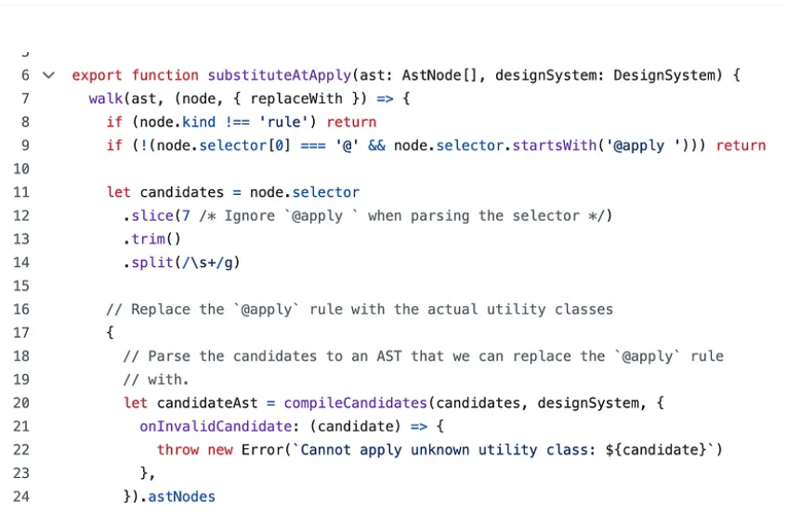Heim >Web-Frontend >js-Tutorial >Wie Tailwind CSS zirkuläre Abhängigkeiten erkennt.
Wie Tailwind CSS zirkuläre Abhängigkeiten erkennt.
- Patricia ArquetteOriginal
- 2024-10-09 06:19:02854Durchsuche

In diesem Artikel analysieren wir den in replacementAtApply ausgelösten Fehler. Bei diesem Fehler handelt es sich um eine erkannte zirkuläre Abhängigkeit.
walk(rule.nodes, (child) => {
if (child !== node) return
throw new Error(
`You cannot \`@apply\` the \`${candidate}\` utility here because it creates a circular dependency.`,
)
})
Dies ist eine allgemeine Übersicht über den Code rund um diesen Fehler.
walk – rekursive Funktion:
Beginnen wir mit dem Spaziergang:
export function walk(
ast: AstNode[],
visit: (
node: AstNode,
utils: {
parent: AstNode | null
replaceWith(newNode: AstNode | AstNode[]): void
context: Record<string, string>
},
) => void | WalkAction,
parent: AstNode | null = null,
context: Record<string, string> = {},
) {
for (let i = 0; i < ast.length; i++) {
let node = ast[i]
// We want context nodes to be transparent in walks. This means that
// whenever we encounter one, we immediately walk through its children and
// furthermore we also don't update the parent.
if (node.kind === 'context') {
walk(node.nodes, visit, parent, { …context, …node.context })
continue
}
let status = visit(node, {
parent,
replaceWith(newNode) {
ast.splice(i, 1, …(Array.isArray(newNode) ? newNode : [newNode]))
// We want to visit the newly replaced node(s), which start at the
// current index (i). By decrementing the index here, the next loop
// will process this position (containing the replaced node) again.
i -
},
context,
}) ?? WalkAction.Continue
// Stop the walk entirely
if (status === WalkAction.Stop) return
// Skip visiting the children of this node
if (status === WalkAction.Skip) continue
if (node.kind === 'rule') {
walk(node.nodes, visit, node, context)
}
}
}
walk ist eine rekursive Funktion in ast.ts.
Es ruft sich selbst rekursiv auf, wenn node.kind === ‚context‘ oder wenn node.kind === ‚rule‘, die Unterbrechungsbedingung basiert auf dem Status
// Stop the walk entirely if (status === WalkAction.Stop) return // Skip visiting the children of this node if (status === WalkAction.Skip) continue
Lassen Sie uns nun etwas herauszoomen und den Code in der Nähe der Walk-Funktion in apply.ts studieren
// Verify that we don't have any circular dependencies by verifying that
// the current node does not appear in the new nodes.
walk(newNodes, (child) => {
if (child !== node) return
// At this point we already know that we have a circular dependency.
//
// Figure out which candidate caused the circular dependency. This will
// help to create a useful error message for the end user.
for (let candidate of candidates) {
let selector = `.${escape(candidate)}`
for (let rule of candidateAst) {
if (rule.kind !== 'rule') continue
if (rule.selector !== selector) continue
walk(rule.nodes, (child) => {
if (child !== node) return
throw new Error(
`You cannot \`@apply\` the \`${candidate}\` utility here because it creates a circular dependency.`,
)
})
}
}
})
TailwindCSS-Autoren haben in der gesamten Codebasis erläuternde Kommentare hinzugefügt, wo dies erforderlich war oder es sinnvoll war, zusätzlichen Kontext bereitzustellen
mit Kommentaren.
Über uns:
Bei Think Throo haben wir die Mission, die fortgeschrittenen Codebasis-Architekturkonzepte zu vermitteln, die in Open-Source-Projekten verwendet werden.
Verzehnfachen Sie Ihre Programmierkenntnisse, indem Sie fortgeschrittene Architekturkonzepte in Next.js/React üben, die Best Practices erlernen und Projekte in Produktionsqualität erstellen.
Wir sind Open Source – https://github.com/thinkthroo/thinkthroo (Geben Sie uns einen Stern!)
Wir bieten auch Webentwicklung und technische Redaktionsdienste an. Kontaktieren Sie uns unter hello@thinkthroo.com, um mehr zu erfahren!
Referenzen:
https://github.com/tailwindlabs/tailwindcss/blob/next/packages/tailwindcss/src/ast.ts#L70
https://github.com/tailwindlabs/tailwindcss/blob/c01b8254e822d4f328674357347ca0532f1283a0/packages/tailwindcss/src/apply.ts
https://stackoverflow.com/questions/71669246/need-help-using-apply-directive-in-tailwind-css
https://github.com/tailwindlabs/tailwindcss/issues/2807
Das obige ist der detaillierte Inhalt vonWie Tailwind CSS zirkuläre Abhängigkeiten erkennt.. Für weitere Informationen folgen Sie bitte anderen verwandten Artikeln auf der PHP chinesischen Website!
In Verbindung stehende Artikel
Mehr sehen- Eine eingehende Analyse der Bootstrap-Listengruppenkomponente
- Detaillierte Erläuterung des JavaScript-Funktions-Curryings
- Vollständiges Beispiel für die Generierung von JS-Passwörtern und die Erkennung der Stärke (mit Download des Demo-Quellcodes)
- Angularjs integriert WeChat UI (weui)
- Wie man mit JavaScript schnell zwischen traditionellem Chinesisch und vereinfachtem Chinesisch wechselt und wie Websites den Wechsel zwischen vereinfachtem und traditionellem Chinesisch unterstützen – Javascript-Kenntnisse

